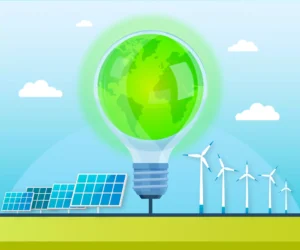
With every passing year, emissions, global warming, and climate change seem to be getting more daunting as the planet’s opponents. Carbon emissions, in particular, have continued to rise unabated throughout the 20th century. Today, they are higher than ever, driving global warming and climate change. These rising emissions have made a case for carbon capture and storage technology. This technology can reduce carbon emissions by transforming its chemical path.
According to the International Energy Agency (IEA), CO2 reached its highest-ever average annual concentration in the atmosphere of 412.5 parts per million in 2020. This level of CO2 is around 50% higher than when the industrial revolution began. The increasing populations in developing countries and rapid economic growth will only worsen these numbers over the next decades. Therefore, we need to take immediate measures today.
Natural carbon sinks, such as forests and oceans, store vast quantities of CO2. However, the unrestricted release of carbon for more than two centuries has exposed the limitations of biological sequestration systems. As a result, artificial solutions have become necessary to suck out the excess carbon in the atmosphere. Carbon capture and storage (CCS) solutions are being eagerly developed and adopted in that context. Several countries are already employing these solutions to reduce carbon emissions. But how exactly does CCS work? Let’s find out.
Carbon capture and storage: understanding the process
Also known as carbon sequestration, carbon capture and storage is a process that artificially captures and stores CO2. The process takes place in three steps:
Step 1: This step involves separating carbon dioxide from the other gases released during industrial processes. These processes include firing coal at power plants, refining oil, etc.
Step 2: In this step, the separated CO2 is compressed into a liquid state. Then, it gets transported through roads, ships, pipelines, or a combination of all three to a pre-determined location. This location is developed specifically for carbon storage.
Step 3: The final step involves injecting the compressed CO2 into deep rock formations several metres below the earth’s surface. Here, the gas is stored permanently.
There are different methods for capturing carbon. The most common ones used are
- Oxyfuel: This technology burns fossil fuels using pure oxygen and produces CO2 and steam.
- Pre-combustion methods: Here, the conversion of the fossil fuel into a mixture of carbon dioxide and hydrogen happens even before the fuel combustion.
- Post-combustion methods: These methods remove CO2 from exhaust gases produced from fossil fuel combustion.
Post-combustion and oxyfuel solutions are more cost-effective than their pre-combustion counterparts since it is possible to retrofit post-combustion and oxyfuel components into the existing machinery. On the other hand, pre-combustion requires extensive modifications and is therefore preferred for new projects.
Where is the captured carbon stored?
Governments worldwide, especially in developed countries, have designated sites for sequestering carbon into empty reservoirs. The reservoirs, in turn, facilitate increased oil production. In the US, for instance, Century Plant in West Texas operates as the country’s largest CCS facility, having a capacity of 8.4 mt/yr (million tons per year). In Australia, the Gorgon Gas Project functions as the country’s flagship carbon storage facility. Here, the sequestered CO2 is injected through wells into the Dupuy Formation, an aquifer (a water-retentive rock) below Barrow Island. Since its operations began in 2020, the facility has stored around 4 mt/yr of carbon dioxide.
Such facilities are cropping up in developing countries as well. For example, in India, the Department of Science and Technology (DST) supports setting up two CCS facilities, one at IIT Bombay and the other at the Jawaharlal Nehru Centre for Advanced Scientific Research (JNCASR), Bengaluru. This effort is significant in the global fight against climate change, as India is one of the biggest carbon emitters.
Decarbonisation, in addition to carbon capture and storage
Decarbonisation refers to any measures made to reduce carbon footprint. Industrial decarbonisation has progressed at an unprecedented pace over the last decade. Large multinationals are now using their limitless resources, expertise, and knowledge to speed up the decarbonisation process and aid the movement toward a net-zero global economy.
Take Honeywell International, for instance. In January 2023, this American conglomerate became the technology provider for the Arthit Carbon Capture and Storage Project in the Gulf of Thailand. Honeywell will be deploying its Separex Membrane Technology (which removes contaminants from natural gas) to store the sequestered CO2 in deep-set reservoirs geologically. In Scandinavia, Norway-based Aker Carbon Capture unveiled the world’s first-ever carbon capture plant for smelters (metal extractors) in January 2023.
In addition, some startups are deftly combining CCS solutions with carbon utilisation. For example, SeeO2 Energy, a startup headquartered in Calgary, Canada, has developed reverse fuel cell technology. This technology not only captures CO2 but also enables its conversion into marketable, value-added, finished products. Private entities’ growing investments in carbon research and development are leading the war against climate change. Solid and consistent policy support from governments to kick off and sustain such initiatives.
Will carbon capture and storage technology tame the beast?
Carbon dioxide plays a dual role in regulating the earth’s climate. Its presence in the atmosphere ensures that the temperature on the surface of the planet remains warm enough for life to thrive. At the same time, excess CO2 in the atmosphere creates a greenhouse effect that makes the earth too warm. The rising temperature will gradually make it impossible for life to exist. Human activities have released copious amounts of CO2 into the atmosphere over the past two-and-a-half centuries, and we now experience its results.
Carbon capture and storage technologies can lead the way in our struggle to contain the impacts of climate change. According to some estimates, CCS solutions can remove up to 90% of the CO2 released through industrial processes and electricity generation. The greater struggle, however, lies in making new carbon capture and storage technologies more accessible and affordable. Only then can the most vulnerable sections in the poorest parts of the world reap the benefits of a carbon-neutral economy.



